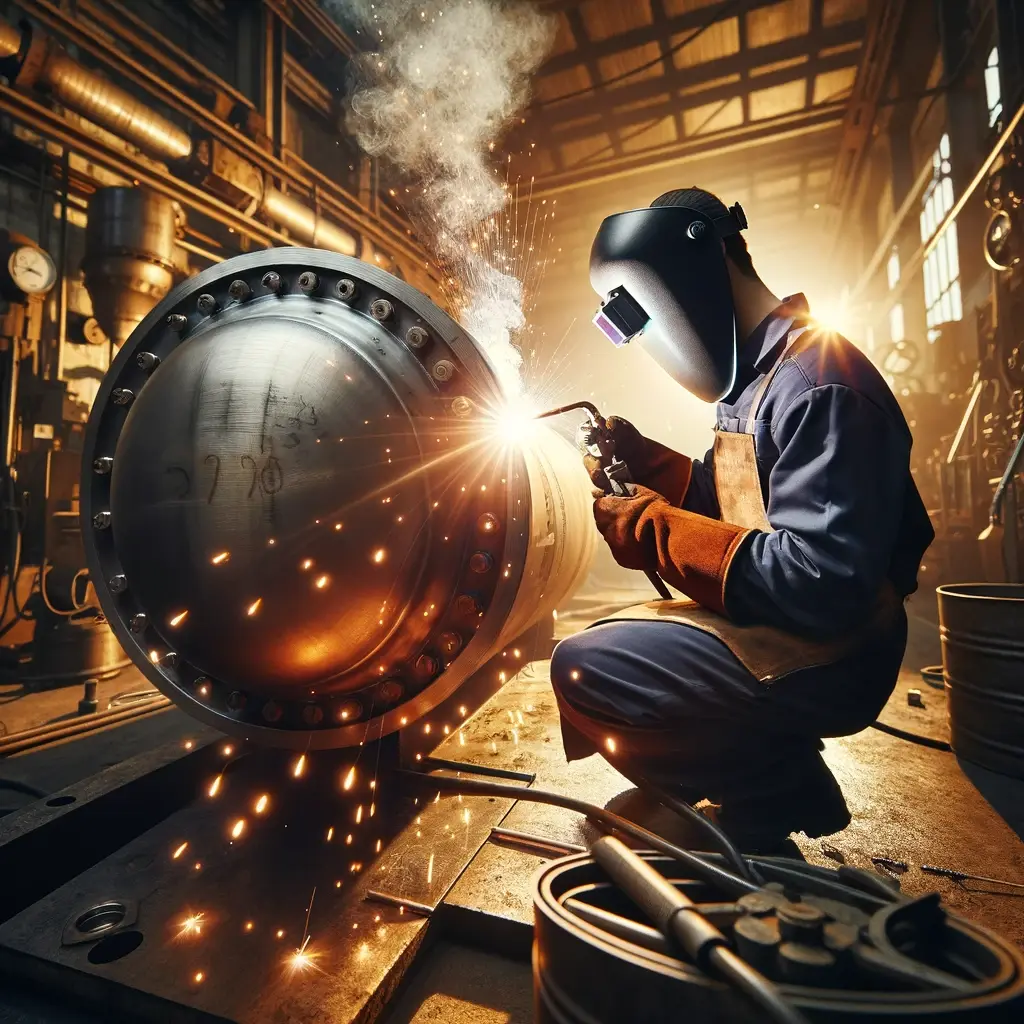
Understanding the Process of Pressure Vessel Manufacturing
In the complex tapestry of modern industrial operations, pressure vessels emerge as critical components, underpinning the functionality of diverse sectors such as petrochemicals, oil and gas, power generation, and pharmaceuticals. These vessels are engineered to operate under pressures that can be vastly higher or lower than the ambient atmosphere, making their design and manufacture a process that demands precision, expertise, and stringent adherence to safety protocols.
The manufacturing journey of a pressure vessel is a testament to the marvels of modern engineering. It begins with a meticulous design phase, transitions through rigorous testing, and culminates in the seamless integration of the vessel into its operational environment. Each step is a dance of precision and expertise, with safety as the lead partner. The process is not just about shaping metal; it’s about crafting a vessel that can reliably contain high-pressure substances while withstanding the rigors of industrial use.
Design and Engineering: The Blueprint of Safety
The first step in pressure vessel manufacturing is the design and engineering phase. This is where the vessel’s blueprint is drawn, taking into consideration the specific requirements of the intended application. The design process is a complex puzzle that involves selecting the right materials, calculating the thickness of the walls, and determining the appropriate shape to withstand internal pressures. It’s a phase where advanced computer simulations come into play, predicting how the vessel will behave under various stress scenarios and ensuring that the final design will hold up to the real-world demands.
Material Selection: The Foundation of Functionality
Choosing the right material is crucial. The selected material must not only be strong enough to handle the internal pressure but also compatible with the chemicals it will contain and the environmental conditions it will face. This could range from carbon steel for durability to stainless steel or even exotic alloys for corrosion resistance. The material selection sets the stage for the vessel’s functionality and longevity.
Fabrication: Turning Designs into Reality
With the design set, the fabrication phase begins. This is where the vessel starts to take shape. Sheets of metal are cut, bent, and formed, using techniques that maintain the integrity of the material. Welding is a critical part of this process, requiring skilled technicians to create joints that are as strong as the vessel’s body. The assembly must be precise; even a minor flaw can be a weak spot under high pressure.
Testing and Quality Assurance: The Seal of Safety
Once assembled, the vessel is subjected to a battery of tests. These are designed to ensure that the vessel can safely hold its contents under operating conditions. Hydrostatic testing, where the vessel is filled with water and pressurized, is a common method for verifying the integrity of the welds and the strength of the vessel. Non-destructive testing techniques, such as X-ray or ultrasonic testing, are used to detect any internal flaws.
Finishing Touches: Preparing for the Field
After passing its tests, the vessel receives its finishing touches. This includes surface treatments to protect against corrosion and heat treatments to relieve stresses within the material. These post-fabrication processes are not merely cosmetic; they are crucial for enhancing the vessel’s performance and lifespan.
Documentation and Compliance: The Paper Trail of Quality
Throughout the manufacturing process, meticulous records are kept. This documentation provides a detailed history of the vessel’s construction and testing, essential for compliance with industry standards and regulations. It’s the paper trail that underscores the quality and safety of the final product.
Installation and Integration: The Vessel’s New Home
The final step in the vessel’s journey is installation and integration into its operational environment. This is where the vessel is put to work, playing its part in the industrial symphony of production and processing.
The process of manufacturing a pressure vessel is a narrative of engineering excellence, where every chapter is about upholding the highest standards of quality and safety. It’s a story that unfolds in the workshops of skilled manufacturers and ends in the facilities of industries that power our world.
Design and Engineering Phase
The genesis of a pressure vessel is in its design and engineering. This initial phase is where concepts take shape, guided by the specific needs of the application. The design process involves selecting the right materials, which must not only withstand high pressures but also be compatible with the substances they will contain. Advanced engineering simulations play a crucial role, predicting how the vessel will behave under operational stresses and allowing engineers to make necessary adjustments before the build begins.
Compliance with Standards
Adherence to standards is non-negotiable in pressure vessel manufacturing. The American Society of Mechanical Engineers (ASME) sets forth a comprehensive set of guidelines that manufacturers must follow. These standards ensure that every vessel is capable of operating safely at the pressures for which it is rated. Certifications are not just badges of honor; they are assurances of a vessel’s integrity and safety.
Fabrication of Pressure Vessels
The fabrication stage is a transformative period in the life cycle of a pressure vessel. It’s where engineering blueprints and material selection converge to create a tangible product. This phase is characterized by a symphony of high-precision machinery and the deft skills of experienced craftsmen.
Cutting and Shaping: The First Cut
The journey begins with the cutting of metal plates. Precision is paramount, as any deviation could compromise the vessel’s integrity. Manufacturers use various cutting methods—plasma torches, laser cutting, and water jet cutters—to ensure the metal is sliced with the utmost accuracy. The chosen method depends on the type of material, the thickness required, and the complexity of the cuts. Each piece is shaped according to the design specifications, ensuring that when assembled, they fit together flawlessly.
Forming: Shaping Under Pressure
Once cut, the metal plates undergo forming processes to shape them into the curved sections of the vessel’s body. This might involve rolling machines that bend the plates into cylindrical forms or presses that mold them into domed ends. The forming process must maintain the metal’s structural integrity, as any weakening could lead to failure under pressure.
Welding: The Bonds That Hold
Welding is the heart of the fabrication process. It’s where the separate pieces are united to form a single, pressure-resistant container. Skilled welders use techniques like TIG (Tungsten Inert Gas) and MIG (Metal Inert Gas) welding to create joints that are as robust as the vessel’s body. The quality of these welds is non-negotiable; they must be perfect. To ensure this, welders often work under the guidance of stringent procedures and inspections.
Assembly: Precision in Unity
The assembly of a pressure vessel is a meticulous task. Each component, whether it’s a shell, head, nozzle, or flange, is positioned with precision. The alignment must be exact, as any misplacement could affect the vessel’s performance. Bolting and riveting are used alongside welding to secure the components in place. This stage requires a harmonious blend of human skill and mechanical assistance to ensure that all parts come together in a seamless and secure fashion.
Inspection: Ensuring Perfection
Throughout the fabrication process, inspection is a constant companion. After each critical step, inspectors check the work, using both visual techniques and advanced methods like ultrasonic testing. These inspections are not just about finding flaws; they’re about verifying that the fabrication process is proceeding according to the exacting standards required.
Testing and Quality Assurance
Once a pressure vessel is assembled, it must undergo rigorous testing. Non-destructive testing (NDT) methods, such as ultrasonic or radiographic inspections, reveal any hidden flaws. Hydrostatic testing, where the vessel is filled with water and pressurized, ensures that it can handle its operational duties. These quality assurance steps are vital for certifying the vessel’s readiness for the field.
Finishing and Post-Treatment Processes
Finishing touches are applied through surface treatments and coatings that protect the vessel from corrosion and wear. Heat treatment processes relieve stresses induced during fabrication, enhancing the vessel’s strength and durability. These post-treatment processes are not just about aesthetics; they are about extending the life of the pressure vessel.
Inspection and Documentation
Before a pressure vessel can leave the manufacturing facility, it undergoes a final inspection to ensure it meets all the required standards and specifications. Documentation is also a critical part of this phase, providing a detailed history of the vessel’s construction and testing, which is essential for traceability and quality assurance.
Delivery and Installation
The journey of a pressure vessel from the manufacturing floor to its final destination is a critical phase that demands as much precision and planning as the fabrication process itself. The delivery of such specialized equipment is not merely a matter of transportation but a complex logistical operation that requires meticulous coordination and expertise.
Logistics of Delivery
Transporting a pressure vessel often involves navigating the challenges of heavy haulage. Given the size and weight of these vessels, manufacturers must work with transportation specialists to plan the safest and most efficient route. This planning includes obtaining necessary permits, ensuring roadworthiness, and sometimes even coordinating with local authorities for route clearances or escorts. The goal is to mitigate risks associated with transportation, such as traffic disruptions, structural road damage, or the vessel incurring damage en route to its new home.
Preparing for Transit
Before the vessel can be loaded for transport, it must be prepared to withstand the rigors of the journey. This involves securing the vessel on a suitable trailer, using cradles or supports designed to accommodate its weight and shape. The vessel is often wrapped or covered to protect it from environmental elements and road debris. Every precaution is taken to ensure that the vessel arrives in the same condition it left the manufacturing facility.
On-Site Installation
Upon arrival at its destination, the pressure vessel enters the installation phase. This is a critical juncture where the vessel must be carefully offloaded and positioned. Cranes and other heavy lifting equipment are typically employed, requiring operators with specialized skills to handle the vessel without compromising its integrity.
Commissioning the Vessel
The commissioning process is where the vessel is integrated into its operational environment. This involves connecting the vessel to existing systems, which may include piping, instrumentation, and controls. It’s a delicate operation that requires the expertise of engineers and technicians to ensure that all connections are secure and leak-free.
Safety Checks and Final Walkthrough
Before the vessel can be declared operational, a series of safety checks and inspections are conducted. This is to verify that the installation aligns with the design specifications and that all safety measures are in place. A final walkthrough is often conducted with the client to ensure that everything meets their expectations and that the vessel is ready to perform its intended function.
Training and Handover
A crucial but sometimes overlooked aspect of the installation process is training the personnel who will operate the vessel. Manufacturers often provide training sessions to ensure that the operators are familiar with the vessel’s features, safety protocols, and maintenance requirements. Once the training is complete, a formal handover takes place, marking the vessel’s readiness for operational duty.
Maintenance and Lifecycle Management
The responsibility of a pressure vessel manufacturer doesn’t end with installation. Routine maintenance is recommended to ensure the vessel continues to operate safely and efficiently. Lifecycle management is also crucial, involving regular inspections and servicing to extend the vessel’s operational life.
Conclusion
The manufacturing process of a pressure vessel is complex and multifaceted, but each step is crucial to ensure the final product can perform its function safely and effectively. From design to delivery, every phase is carried out with precision and care, reflecting the importance of these vessels in industrial applications.
Need a reliable partner?
Red River specializes in the design and manufacturing of pressure vessels. We also fabricate related items such as prefabricated spools and skid packages.
Reach Out to us today and experience the Red River difference. Where American Made and American Values come together, we care more.
FAQ: Understanding the Process of Pressure Vessel Manufacturing
1. What materials are commonly used in the manufacturing of pressure vessels, and how are they selected?
The selection of materials for pressure vessels is critical and depends on the vessel’s intended use, the type of substances it will contain (liquids, gases, or vapors), operating temperature, and pressure conditions. Common materials include carbon steel, stainless steel, aluminum, and nickel alloys. The choice is influenced by factors such as strength, corrosion resistance, impact resistance at low temperatures, and cost. For example, stainless steel is preferred for its corrosion resistance, while carbon steel is chosen for its durability and cost-effectiveness in less corrosive environments.
2. How does the design process of a pressure vessel ensure safety and compliance with standards?
The design process of a pressure vessel involves meticulous calculations and adherence to international standards such as the ASME Boiler and Pressure Vessel Code in the United States or the Pressure Equipment Directive in Europe. These standards dictate the design criteria, including the minimum thickness of the vessel walls, stress analysis, and safety factors to ensure the vessel can withstand the maximum operating pressure and temperature. Additionally, the design process includes the selection of appropriate materials and the incorporation of safety features like pressure relief valves. This rigorous design phase is crucial for ensuring the vessel’s safety and operational efficiency.
3. What are the key steps involved in the manufacturing process of pressure vessels?
The manufacturing process of pressure vessels typically involves several key steps: material selection and preparation, cutting and shaping, welding, testing, and finishing. Initially, the selected material is cut and shaped into the desired form, often involving processes like rolling and forging. Welding is a critical step where sections are joined together, requiring high precision to ensure structural integrity. The vessel then undergoes various tests, including hydrostatic testing, to verify its strength and leak-proof nature. Finally, finishing touches are applied, such as painting or coating, to enhance corrosion resistance.
4. Can pressure vessels be customized, and what factors influence their customization?
Yes, pressure vessels can be highly customized to meet specific operational requirements. Factors influencing customization include the vessel’s capacity, the pressure and temperature it needs to withstand, the type of substance it will hold, and the environment in which it will operate. Customization can affect the vessel’s size, shape, material, and the inclusion of specific features like nozzles, manways, and supports. The customization process involves close collaboration between the client and the manufacturer to ensure the final product meets all operational and safety standards.
5. What are the maintenance and inspection requirements for pressure vessels?
Maintenance and inspection are crucial for the safe and efficient operation of pressure vessels. Regular inspections are mandated by regulatory standards and may include both internal and external examinations, pressure testing, and the inspection of safety devices. Maintenance involves routine checks, cleaning, and the replacement of worn or damaged parts to prevent leaks, corrosion, and other failures. The frequency and extent of maintenance and inspection depend on the vessel’s age, operating conditions, and the nature of the substances it contains. Adhering to these requirements helps in extending the lifespan of the vessel and ensuring the safety of operations.
Related Blog Post
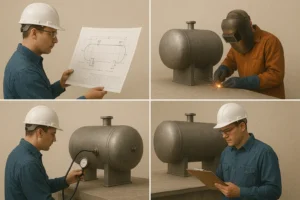
Pressure Vessel Design & Engineering: Concept to Launch
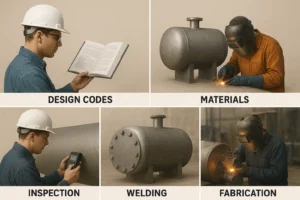
What is Pressure Vessel Design and Engineering: Code-Ready Guide
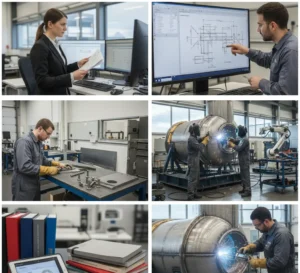
What are the Key Factors in Pressure Vessel Engineering
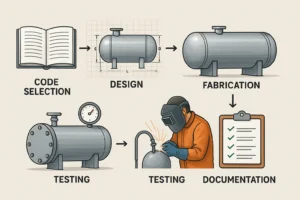
How Do You Design a Pressure Vessel: A Step-By-Step Guide
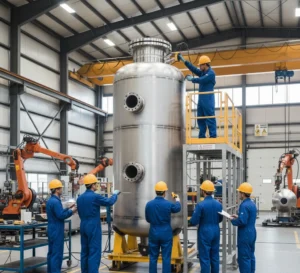
What is Pressure Vessel Fabrication and Manufacturing
About Author

